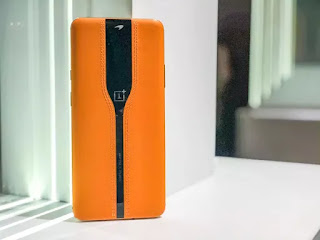Oneplus X McLaren Edition (7t Pro) 'invisible camera' with colour shifting glass technology called concept one!
OnePlus Concept One is the first phone from the company to use colour-shifting glass technology (electrochromic glass technology) giving it an “invisible camera” design feel.
Key Highlights
•OnePlus claims that the Concept One is the industry's first smartphone with a disappearing rear camera
•The OnePlus Concept One is an alternate design approach for an alternate vision of the future says the company
•The electrochromic glass used by OnePlus has already been put to use in some limited applications in cars and planes.
OnePlus has launched its first-ever concept phone, the OnePlus Concept One, at the CES 2020 in Las Vegas. The company has yet again collaborated with McLaren for the concept phone's design. One of the biggest talking points of the Concept One smartphone is its disappearing rear camera which the company also calls “invisible camera” design. OnePlus says it drew inspiration from similar technology used in McLaren's 720S luxury sports car which features a glass roof panel that can alter its tint and control the amount of light allowed through.
Chinese phone-maker OnePlus generally keeps a quiet presence at CES, preferring instead to hold off any phone news until after the show in the spring and fall. But during a press conference at this year's biggest tech show, it
announced its first concept phone, known as the OnePlus Concept One. The Concept One features a special glass that uses an electrical current to tint the lens of the rear cameras, making them "disappear." When the cameras aren't in use, the glass is opaque and black. When it's time to launch the camera, the glass turns transparent and the cameras are visible.
Though largely for aesthetics and novelty, the feature does double as a neutral-density filter for the camera, letting you tweak a photo's exposure. (You can turn it on and off in the Pro mode of the camera.) The idea sounds nifty enough, especially as a camera filter. The switch also works pretty quickly; it takes less than a second -- 0.7 second to be exact, about the same amount of time it takes to launch the camera, according to OnePlus.
But up close, it's a little underwhelming. Personally, I never really had an issue with seeing camera lenses. While it's true that
Apple and Google raised some eyebrows last year with their obtrusive square camera bumps, it was the thickness and size of the bumps themselves that bothered people, not the visibility of the lenses.
The OnePlus Concept One's product manager, Xi Zeng, also emphasized during the presser how this feature embodies "beauty in the unseen" and the company's "burdenless philosophy." As more phones add more cameras, we'll reach a point where we'd want to obscure them.
I'd understand this if OnePlus showed off the feature on an all-black phone. But the company demonstrated it on last year's
OnePlus 7T Pro with a loud orange design (branded "papaya orange") that looks like it's wearing a laceless corset. This may not be the final look of the phone once it's released, but all that leather and orange and stitching and extra lines OnePlus highlighted weren't exactly minimalistic.
OnePlus worked on the phone for 18 months and got the idea through its partnership with supercar company McLaren. You can see this kind of opaque-transforming glass, known as electrochromic glass, in the sunroofs of luxury cars like those made by McLaren, but it's also in office windows and fancy club bathroom mirrors. I myself have seen it in those environments… on TV.
The phone kind of reminded me of those ridiculous, leather-clad $5,000 Vertu luxury phones, except slightly better looking. And since OnePlus' device will be more expensive than its regular phones given all the R&D and materials that went into it, it's a wonder who exactly this phone is for other than rich, diehard McLaren fans. As for specific details, the company didn't announce pricing or availability.
OnePlus is continuing to explore different applications of electrochromic glass, so perhaps in the near future we'll see a OnePlus phone that can change the transparency of its whole back (in case you wanted to look at your battery once in a while?). For now, the Concept One isn't as ambitious and far-reaching as concept phones go, but it still marks the company's first CES announcement and offers an early glimpse of where OnePlus is heading.























Comments
Post a Comment